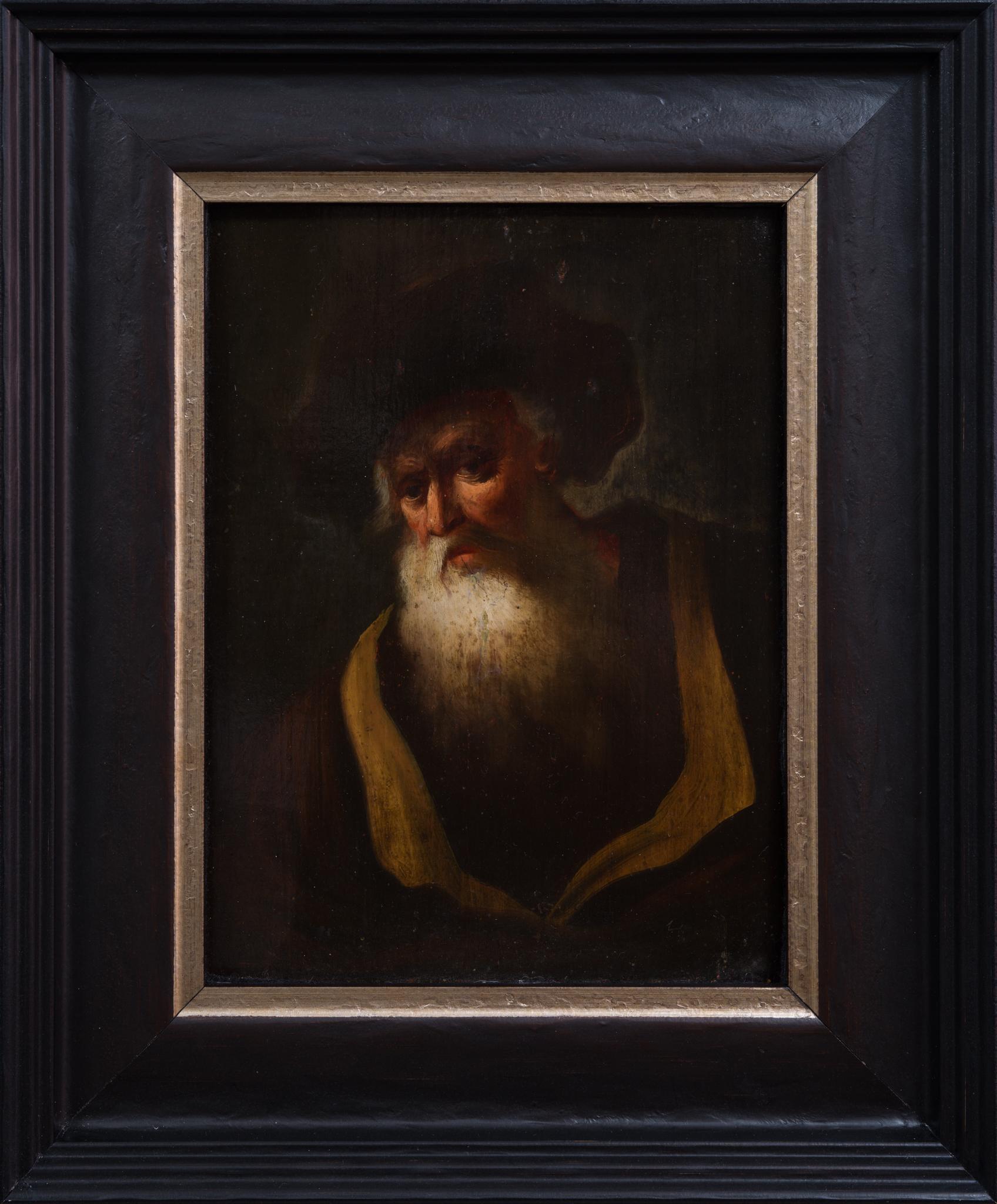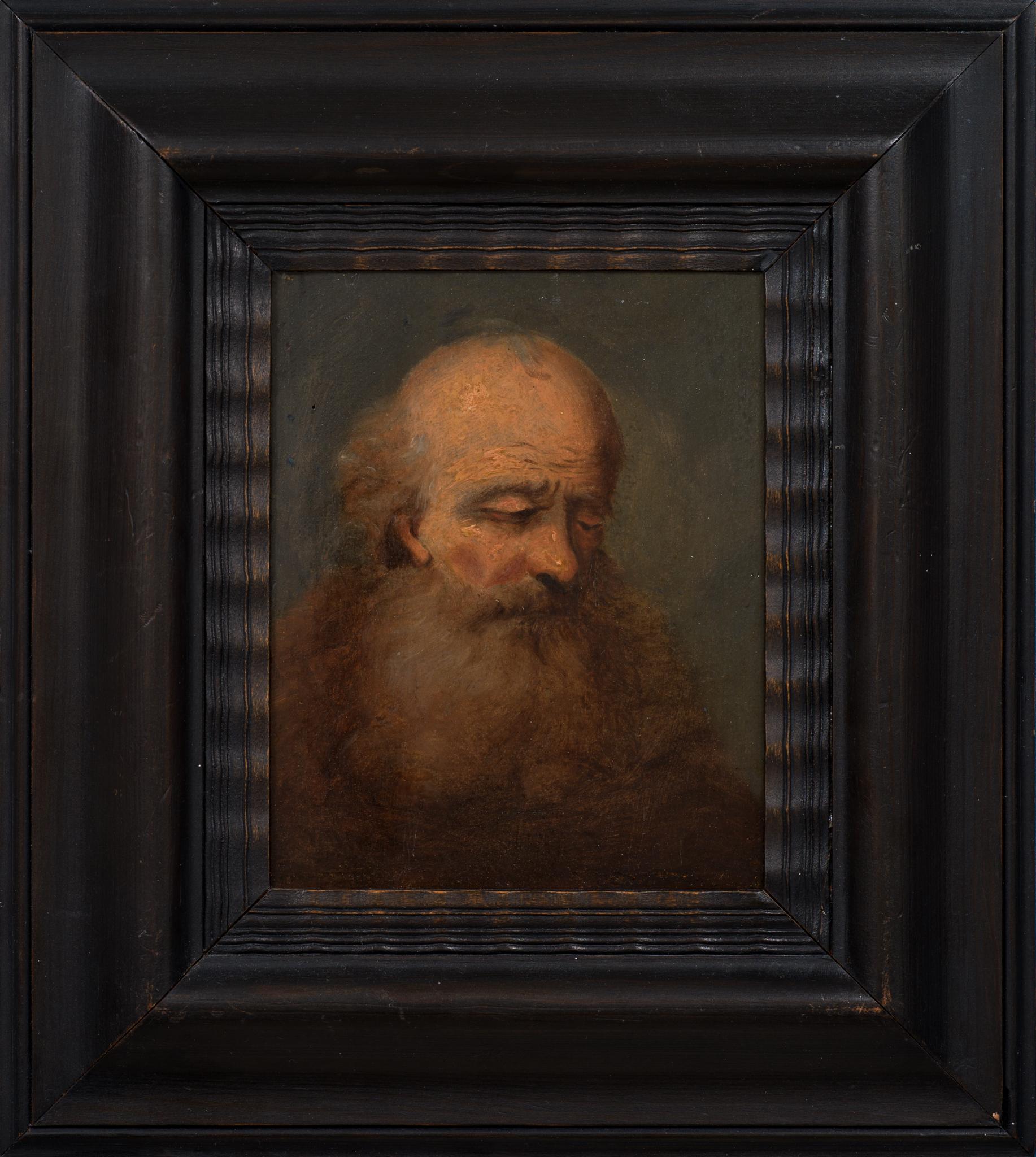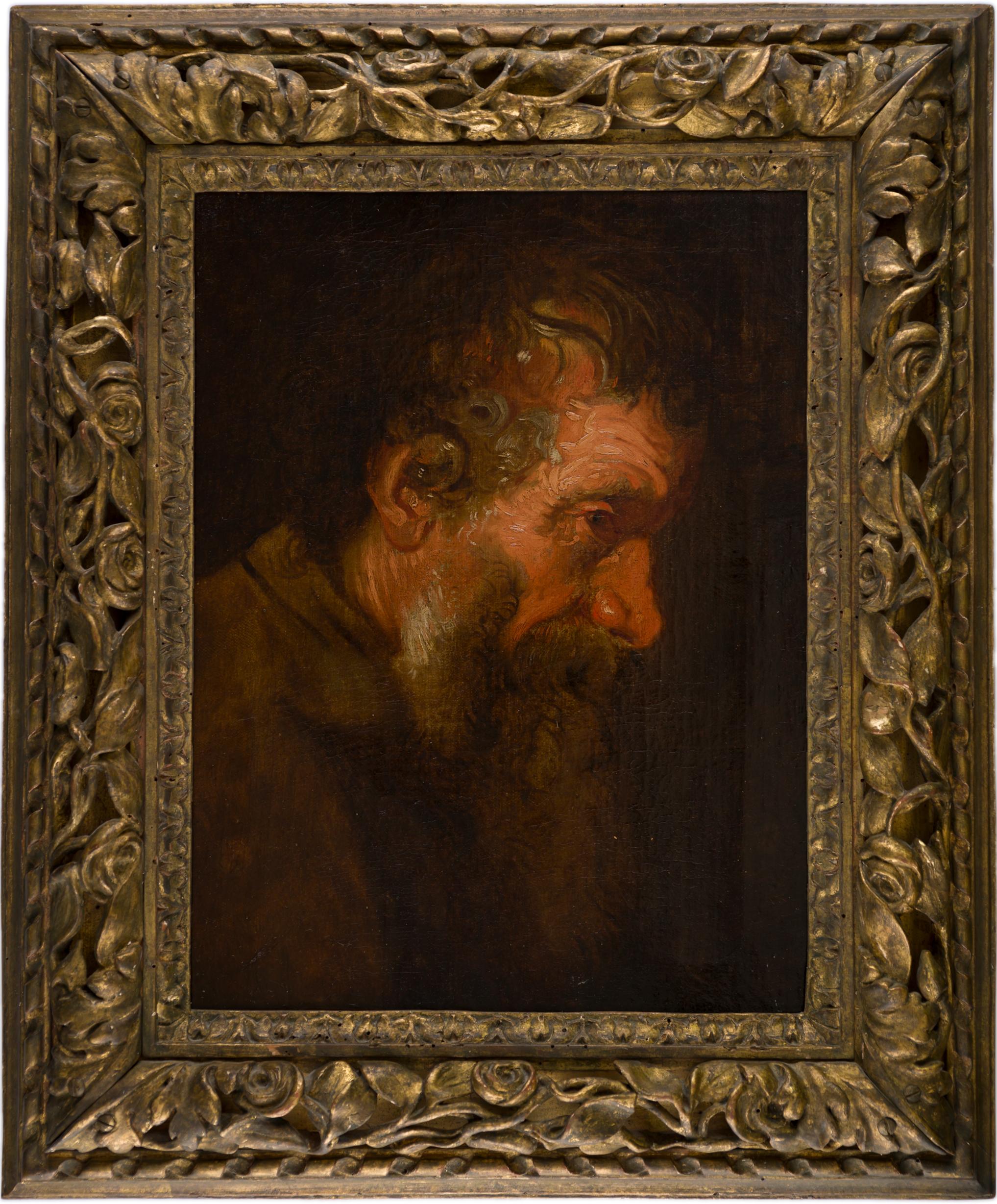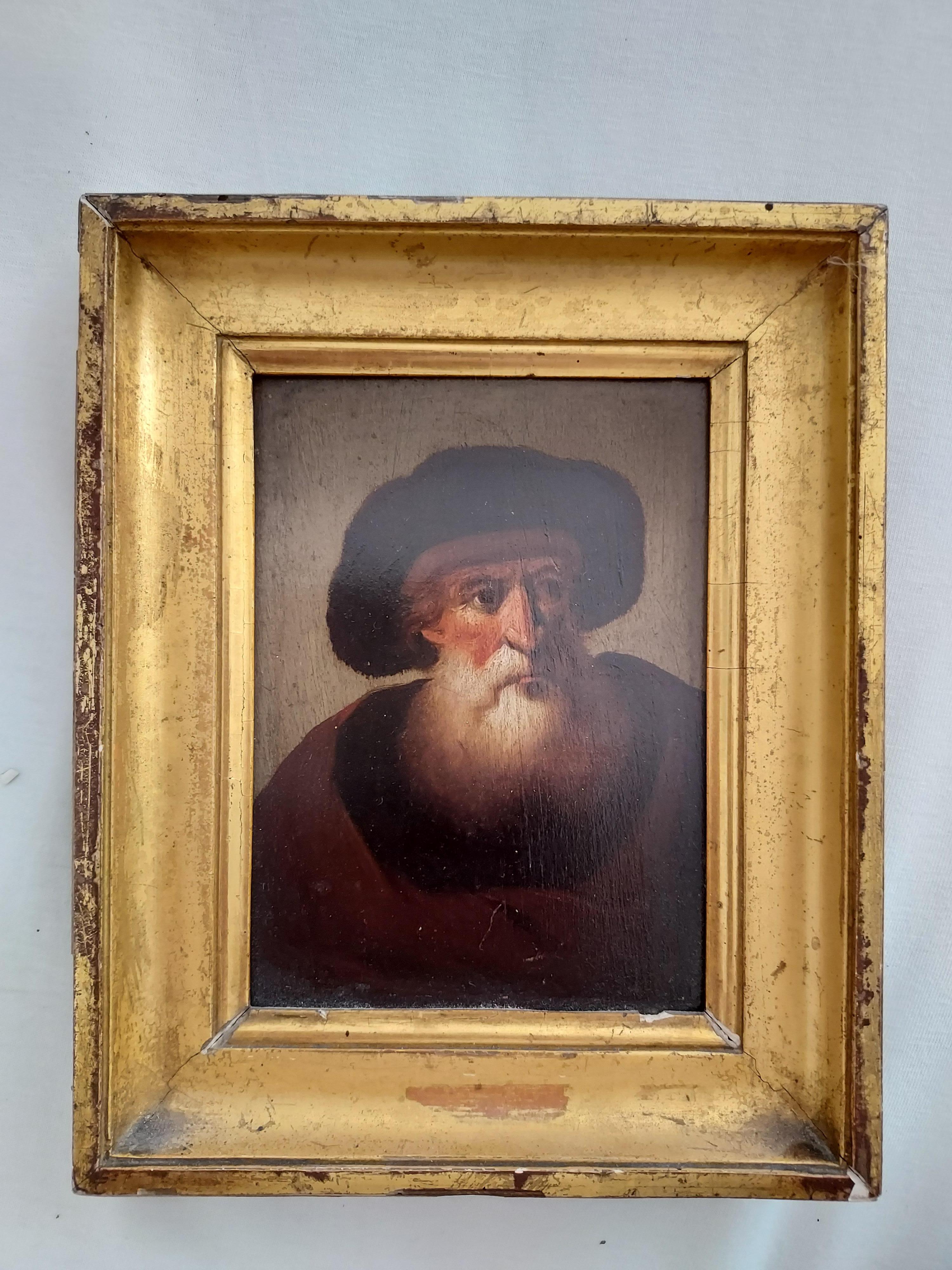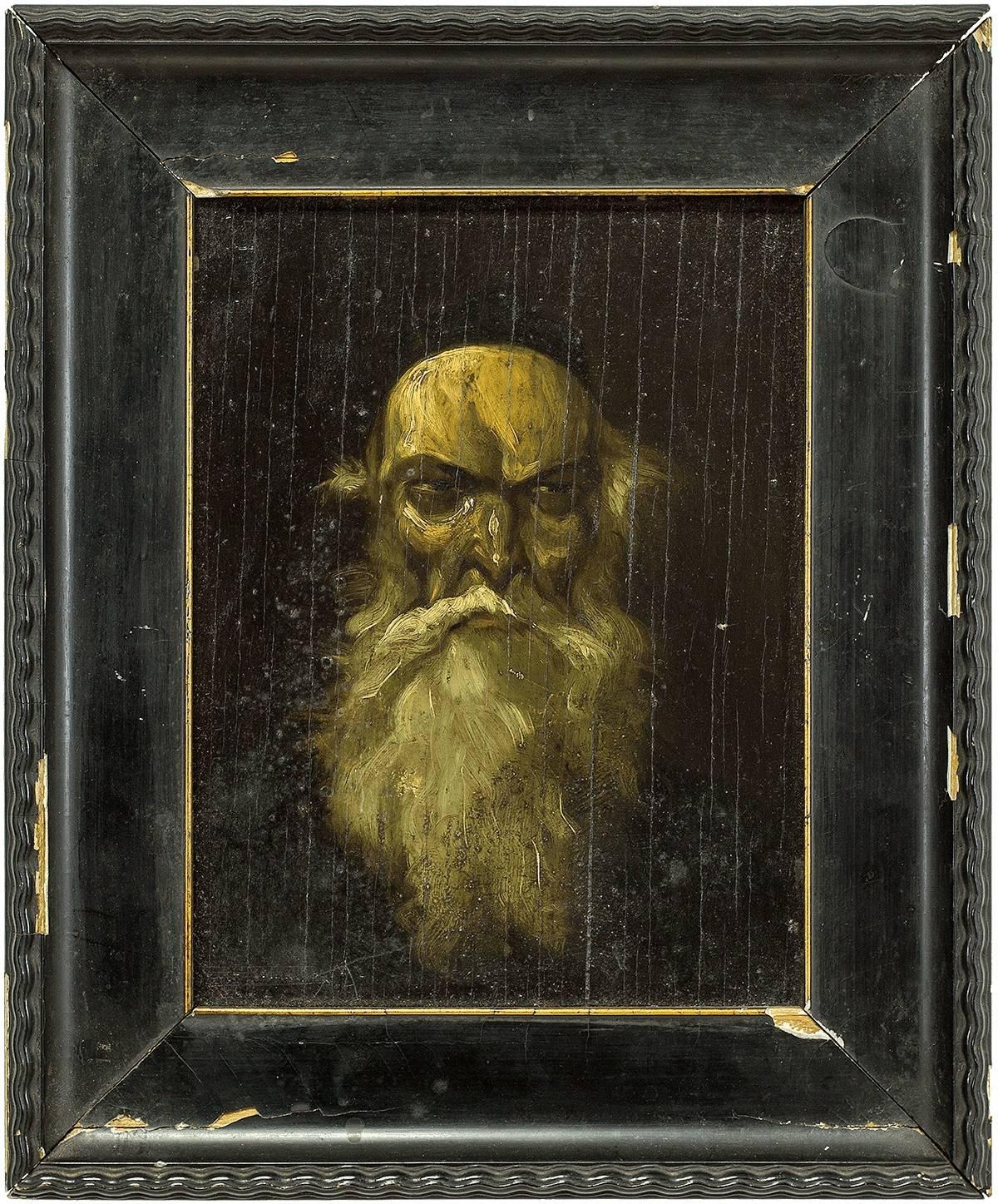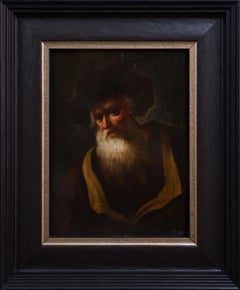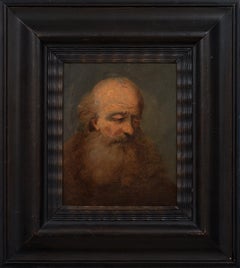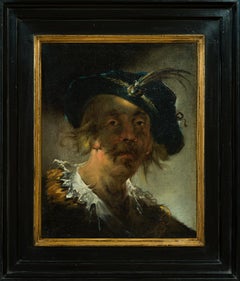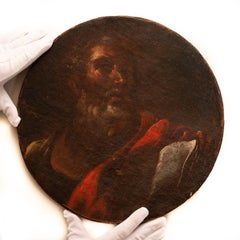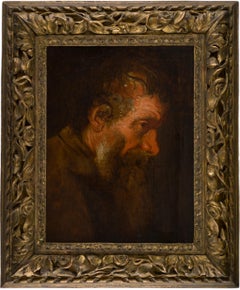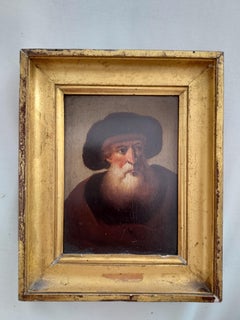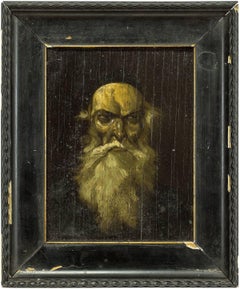Items Similar to Portrait of an Old Bearded Man
Want more images or videos?
Request additional images or videos from the seller
1 of 10
Portrait of an Old Bearded Manlate 1700s c.
late 1700s c.
$2,834.53
£2,133.97
€2,400
CA$3,904.76
A$4,373.08
CHF 2,281.80
MX$53,415.32
NOK 29,031.17
SEK 27,365.36
DKK 18,269.12
About the Item
We are pleased to offer a captivating portrait, most likely painted in the late 18th century, attributed to an artist within the circle of Christian Wilhelm Ernst Dietrich. This oil painting portrays a distinguished elderly man with a solemn and thoughtful expression. His face is framed by a full, white beard, and he wears a soft hat in muted tones of brown and red, lending a sense of quiet dignity and contemplation to his appearance.
The subject's eyes are downcast, perhaps reflecting a moment of introspection. The fine details of his weathered skin and the careful rendering of his features showcase the artist's skill in capturing the essence of character and emotion. The use of light and shadow adds depth to the composition, highlighting the textures of his garments—a rich brown robe with a yellow collar that peeks through, adding a subtle touch of color contrast.
The painting is executed with a muted color palette, emphasizing the subject's serene and introspective mood. The background is kept simple and dark, focusing the viewer's attention on the man's expressive face. This piece offers a window into the stylistic tendencies of Dietrich's circle, combining elements of realism with a touch of romantic sentiment.
oil on wood panel
unframed 25.5 x 18.7 cm
framed 36 x 30 cm
- Creation Year:late 1700s c.
- Dimensions:Height: 14.18 in (36 cm)Width: 11.82 in (30 cm)
- Medium:
- Movement & Style:
- Circle Of:Christian Wilhelm Ernst Dietrich (1712 - 1774)
- Period:
- Condition:The portrait is in fine condition with an old varnish and a few minor retouchings. It has developed a beautiful, aged patina. A newly crafted black frame is included.
- Gallery Location:Stockholm, SE
- Reference Number:1stDibs: LU1445214897792
About the Seller
5.0
Platinum Seller
Premium sellers with a 4.7+ rating and 24-hour response times
Established in 2020
1stDibs seller since 2020
189 sales on 1stDibs
Typical response time: <1 hour
Associations
International Confederation of Art and Antique Dealers' Associations
- ShippingRetrieving quote...Shipping from: Stockholm, Sweden
- Return Policy
Authenticity Guarantee
In the unlikely event there’s an issue with an item’s authenticity, contact us within 1 year for a full refund. DetailsMoney-Back Guarantee
If your item is not as described, is damaged in transit, or does not arrive, contact us within 7 days for a full refund. Details24-Hour Cancellation
You have a 24-hour grace period in which to reconsider your purchase, with no questions asked.Vetted Professional Sellers
Our world-class sellers must adhere to strict standards for service and quality, maintaining the integrity of our listings.Price-Match Guarantee
If you find that a seller listed the same item for a lower price elsewhere, we’ll match it.Trusted Global Delivery
Our best-in-class carrier network provides specialized shipping options worldwide, including custom delivery.More From This Seller
View AllPortrait of an Old Bearded Man With a Black Cap
Located in Stockholm, SE
We are pleased to offer a captivating portrait, most likely painted in the late 18th century, attributed to an artist within the circle of Christian Wilhelm Ernst Dietrich. This oil ...
Category
Late 18th Century Old Masters Portrait Paintings
Materials
Oil, Wood Panel
Portrait of an Elderly Man
Located in Stockholm, SE
This finely executed oil painting, attributed to the circle of Christian Wilhelm Ernst Dietrich, captures the contemplative expression of an elderly man, his gaze lowered in quiet re...
Category
Early 19th Century Old Masters Portrait Paintings
Materials
Oil, Wood Panel
Portrait of a Man – A Dramatic Study in Light and Expression
Located in Stockholm, SE
This compelling portrait, recently studied by Stéphane Pinta of the esteemed Cabinet Turquin in Paris, has been confidently attributed to the Austrian painter Matthäus (Matthias) Lod...
Category
Late 18th Century Old Masters Portrait Paintings
Materials
Canvas, Oil
An Apostle Painted in the Circle of Peter Paul Rubens, Oil on Canvas
Located in Stockholm, SE
Peter Paul Rubens (circle of)
An Apostle
circular 15.15 inches (38.5 cm)
oil on canvas
Provenance: Bukowskis Auctions, lot 725149, as "Peter Paul Rubens, circle of".
Category
17th Century Portrait Paintings
Materials
Canvas, Oil
Rediscovered Mastery: A Portrait by Nina Bergstedt
Located in Stockholm, SE
This poignant portrait by Swedish artist Nina Bergstedt captures a quiet intensity that lingers in the viewer’s mind. The sitter, an unknown woman, is portrayed with deep emotional p...
Category
1890s Realist Portrait Paintings
Materials
Canvas, Oil
Portrait of a Man from the Rif Region
Located in Stockholm, SE
This watercolour portrait by Finnish artist Hugo Backmansson depicts an Arab man from the Rif region of Morocco. Created during Backmansson’s journey to Morocco in 1939, the work cap...
Category
1930s Portrait Drawings and Watercolors
Materials
Paper, Watercolor
$3,300 Sale Price
20% Off
You May Also Like
Study of a Bearded Man's Head
By Anthony van Dyck
Located in Paris, Île-de-France
Studio of Van Dyck (Antwerp, early 17th century)
Study of a Bearded Man's Head
Oil on canvas,
46 x 34 cm
Inscribed on the reverse of the stretcher: “Etude de ... / vente du ... ; J...
Category
17th Century Old Masters Portrait Paintings
Materials
Canvas, Oil
Portrait d'Homme Barbu German School oil on pannel
Located in Pasadena, CA
Pretty portrait representing a portrait of an old shepherd from the German school in Dusseldorf . Oil on pannel
Category
19th Century Romantic Portrait Paintings
Materials
Oil
Portrait of a Rabbi
Located in Surfside, FL
Judaica Oil Painting, Portrait of a Rabbi.
Category
20th Century Modern Portrait Paintings
Materials
Oil, Board
Portrait of a Old Man XIX Oil on canvas
Located in Pasadena, CA
Oil painting on panel probably depicting an Orthodox priest of Russian origin.
Dated 1872. Signed but not legible signature
Category
19th Century Romantic Figurative Paintings
Materials
Oil
Portrait of a Russian Artist or Dignitary
Located in Stockholm, SE
This 19th-century oil on canvas portrait depicts a distinguished male figure—probably Russian and possibly an artist or a dignitary—with a striking resemblance to the renowned Russia...
Category
19th Century Portrait Paintings
Materials
Canvas, Oil
Antique Italian painter - 18th century figure painting
Located in Varmo, IT
Italian painter (18th century) - Chrono.
90.5 x 106 cm.
Antique oil painting on canvas, without frame (not signed).
Condition report: Lined canvas. Good state of conservation of t...
Category
Early 18th Century Old Masters Figurative Paintings
Materials
Canvas, Oil
$4,714 Sale Price
20% Off
More Ways To Browse
Old Wood Art
Antique Christian Painting
Robe Man
Christian Wilhelm Ernst Dietrich
Dean Antiques
Justin Wells
Charles Edward Stuart
Francis Edward James
Hyacinthe Rigaud
Mary Richardson
Sir Anthony Van Dyck
Vintage Swiss Boys
Womans Fur Coat
Artist Smock
Gonzaga Painting
Mercedes Benz Vintage Cars
Painted Jean Jacket
Paul Keene
